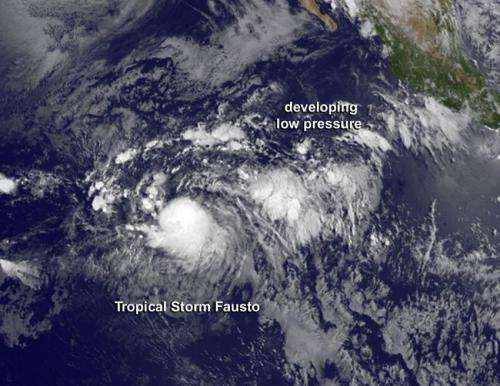Satellite sees newborn Tropical Storm Fausto being 'chased'

Tropical Storm Fausto was literally born yesterday and strengthened to a tropical storm quickly. Satellite imagery from NOAA's GOES-West satellite shows a rounded Fausto being "chased" by a developing area of low pressure to the east of the storm.
NOAA's Geostationary Operational Environmental Satellite GOES-West captured a combination visible and infrared image of the Eastern Pacific on July 8 at 1500 UTC (10 a.m. EDT). In the image, Tropical Storm Fausto appeared as a rounded area of clouds, compared to the amorphous developing low pressure area behind it.
At 6:30 p.m. EDT on July 7, Tropical Depression Six-E formed in the Eastern Pacific about 1,145 miles (1,840 km) southwest of the southern tip of Baja California, Mexico. The depression strengthened into Tropical Storm Fausto by 11:00 p.m. EDT.
On July 8 at 11 a.m. EDT (1500 UTC), Tropical Storm Fausto had maximum sustained winds near 45 mph (75 kph) and is expected to strengthen slightly. Fausto was centered near latitude 9.7 north and longitude 123.2 west, about 1,265 miles (2,040 km) southwest of the southern tip of Baja California. Fausto is moving toward the west near 14 mph (22 kph) and the National Hurricane Center (NHC) expects a westward to West-northwestward motion at a slightly faster forward speed over the next 48 hours. The estimated minimum central pressure is 1005 millibars.
NHC forecaster Pasch noted in the 11 a.m. EDT discussion, "the center is not easy to locate, even on first-light visible images, but microwave imagery suggest that it is near the northern edge of the main area of deep convection (rising air that forms thunderstorms that make up the tropical cyclone)."
NHC expects Fausto to peak on July 9 before weakening again.
To the west of Fausto is another developing area of low pressure. Shower activity associated with a broad trough of low pressure, several hundred miles southwest of Manzanillo, Mexico. That low pressure area has become less organized over the past day. The NHC noted that development, if any should be slow to occur during the next two day as it moves west-northwestward at 10 to 15 mph. After 48 hours, upper level winds are expected to become less conducive for development.
Provided by NASA's Goddard Space Flight Center





















